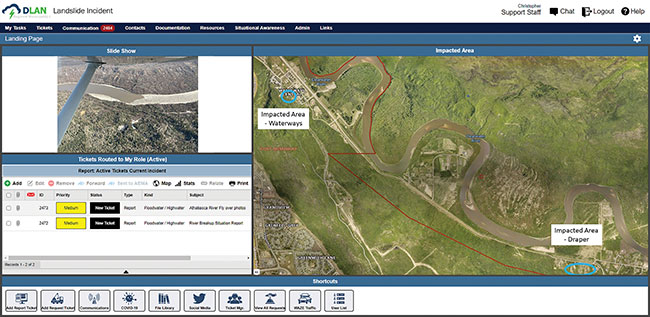
Features
Emergency & disaster management
Helming communications: emergency software
Creating a common operating picture in crisis with emergency management software
November 4, 2021
By
Laura Aiken
 This mock-up of a landslide response shows some of the key functions DisasterLAN provides as a collaborative tool.
Photo Credit: Scott Davis, MA
This mock-up of a landslide response shows some of the key functions DisasterLAN provides as a collaborative tool.
Photo Credit: Scott Davis, MA Scott Davis first became aware of the DisasterLAN (DLAN) emergency software during the Toronto 2015 Pan-Am Games. Davis, now vice-president of Community Disaster Response in Ontario, was in emergency management with Peel region public health in Ontario at the time, and was impressed by its capabilities.
Davis then moved to Kingston to be the manager for the office of emergency management and a chief officer with Kingston Fire and Rescue. He said he found the virtual disaster response system to be lacking and decided to replace it with DLAN because of his experience in Peel. Davis worked with Buffalo computer graphics and FutureShield, the sole Canadian distributor of DLAN, to tailor DLAN into the incident management system that he said Ontario’s emergency management office was aspiring to follow. The system proved itself during large-scale events.
“I can remember one incident that we had a severe snowstorm, to the point where we were shutting down snow plows. I was at the Emergency Operations Centre, but I could post the situation reports for senior leadership to be able to understand what was going on. And, in fact, the CAO participated from his home because he was snowed in,” he said. “We went through a number of different incidents that I use DisasterLAN for, including a mass vehicle collision on highway 401 involving about 26 vehicles and hazardous materials. I was able to keep track of what was going on and provide the incident management team with updates throughout the disaster. They could just log in and see the same picture, the common operating picture, that I was seeing.”
In Kingston, Davis also put the system to work in helping prepare for the last Tragically Hip concert in 2016 by providing situational awareness to the different agencies, including police, fire, EMS and Public Works.
Davis then took on the role of director of emergency management for the Regional Municipality of Wood Buffalo in Alberta, Canada’s second largest regional government, where wildfires are a primary concern. He also held a chief officer role with the region’s emergency services. He began implementing a basic DisasterLAN system at the beginning of the COVID-19 pandemic that could help the incident management team get up and running quickly, and over the last year has expanded the system to accommodate the all-hazards response required of today’s fire service.
DisasterLAN also helped address council’s strategic objective of engaging rural municipalities and Indigenous partners in emergency management, while also considering compatibilities in communicating with provincial partners.
When it came to training, he says he adopted a “crawl, walk, run” methodology, keeping in mind that members of incident management teams and emergency management leadership don’t do emergencies every day.
“In Alberta, under the local authority and emergency management regulation, there’s a move to change from the terminology of Emergency Operations Centre to Emergency Coordination Centre, or ECC. And I really like that because it takes away that idea that the EOC is the one that’s making the decisions and running the incident when really the EOC’s purpose is to support the incident command post. I like this ECC concept of coordination and how it relates to Disaster LAN. It’s a coordination tool to bring all the partners together.”
In practice, DLAN brings together facets such as command, operations, planning, logistics, finance, and administration so that everyone can track the movements of the operation and know their specific accountability, all while being able to make requests to each other through tickets and offer the flexibility to work through any level of incident.
“Whether it’s a designated emergency manager, or whether it’s a volunteer fire chief that does emergency management off the side of their desk, the main benefit is what we call that common operating picture.”
Print this page